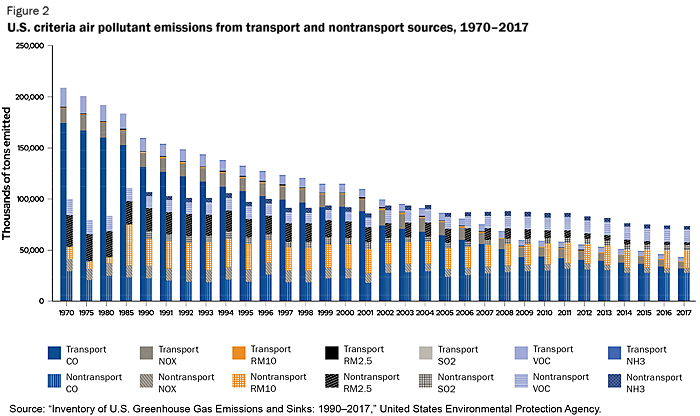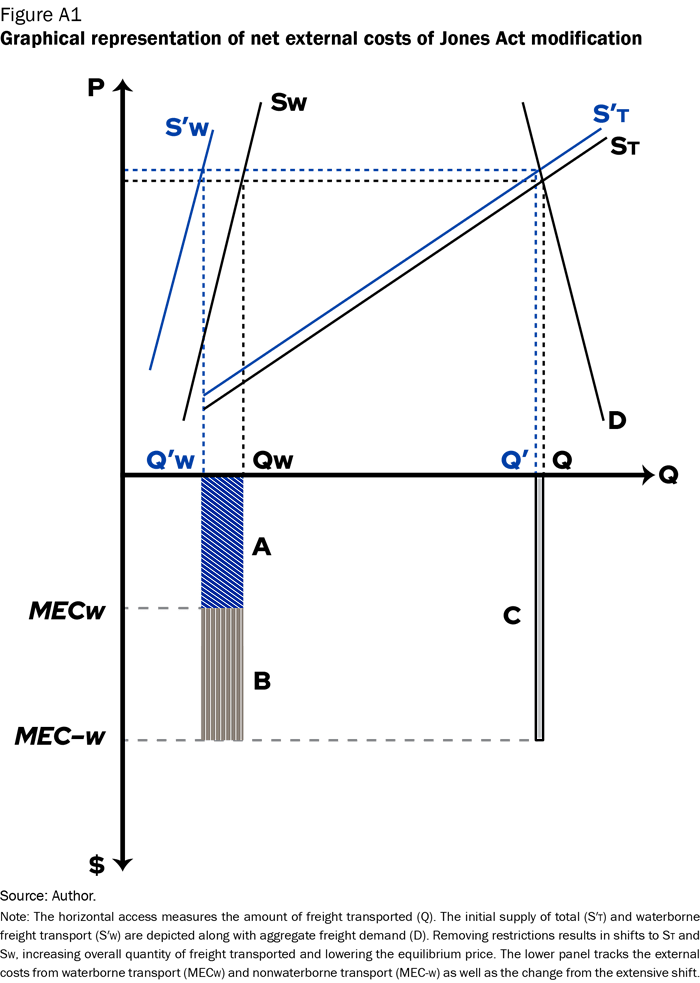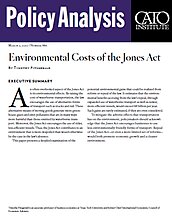1. “Commodity Flow Survey Data and Reports,” Bureau of Transportation Statistics.
2. Colin Grabow, Inu Manak, and Daniel Ikenson, “The Jones Act: a Burden America Can No Longer Bear,” Cato Institute Policy Analysis no. 845, June 28, 2018.
3. Rob Quartel, “America’s Welfare Queen Fleet: the Need for Maritime Policy Reform,” Regulation 14, no. 3 (1991): 58–67.
4. “2014 National Emissions Inventory (NEI) Data,” United States Environmental Protection Agency.
5. Valerie M. Thomas, “The Elimination of Lead in Gasoline,” Annual Review of Energy and the Environment 20, no. 1 (1995): 301–24.
6. Nicholas Z. Muller and Robert Mendelsohn, “Measuring the Damages of Air Pollution in the United States,” Journal of Environmental Economics and Management 54, no. 1 (2007): 1–14.
7. Nicholas Z. Muller, Robert Mendelsohn, and William Nordhaus, “Environmental Accounting for Pollution in the United States Economy,” American Economic Review 101, no. 5 (2011): 1649–75.
8. “National Transportation Statistics, 2019,” Bureau of Transportation Statistics, https://www.bts.dot.gov/topics/national-transportation-statistics.
9. “Comparison of U.S. and Foreign-Flag Operating Costs,” United States Department of Transportation Maritime Administration, September 2011, https://www.maritime.dot.gov/outreach/publications/comparison-us-and-foreign-flag-operating-costs.
10. U.S. Government Accountability Office, “Maritime Security: DOT Needs to Expeditiously Finalize the Required National Maritime Strategy for Sustaining U.S.-Flag Fleet,” GAO-18–478 (Washington: GAO, 2018).
11. Aframax is a standard tanker designation representing medium-sized tankers between 80,000 and 120,000 deadweight tons.
12. “The Economic Effects of Significant U.S. Import Restraints,” U.S. International Trade Commission, Third Update, Publication no. 3519, June 2002, https://www.usitc.gov/publications/332/pub3519.pdf; “The Economic Effects of Significant U.S. Import Restraints,” U.S. International Trade Commission, Second Update, Publication no. 3201, May 1999, https://www.usitc.gov/publications/332/pub3201.pdf.
13. “Services Trade Restrictiveness Index Regulatory Database,” Organisation for Economic Co-operation and Development, https://qdd.oecd.org/subject.aspx?Subject=063bee63-475f-427c-8b50-c19bffa7392d.
14. “The Economic Effects of Significant U.S. Import Restraints,” U.S. International Trade Commission, Third Update.
15. Gary Clyde Hufbauer and Kimberly Ann Elliott, Measuring the Costs of Protection in the United States (Washington: Peterson Institute for International Economics, 1994).
16. Joseph Francois, Hugh M. Arce, Kenneth A. Reinart, and Joseph E. Flynn, “Commercial Policy and the Domestic Carrying Trade,” Canadian Journal of Economics 29, no. 1 (1996): 181–98.
17. “National Transportation Statistics, 2019.”
18. “Inventory of U.S. Greenhouse Gas Emissions and Sinks: 1990–2017,” United States Environmental Protection Agency.
19. “GIFT—Geospatial Intermodal Freight Transport Model,” Laboratory for Environmental Computing and Decision Making, https://www.rit.edu/gccis/lecdm/gift2.php.
20. Bryan Comer, James J. Corbett, J. Scott Hawker, Karl Korfmacher, Earl E. Lee, Chris Prokop, and James J. Winebrake, “Marine Vessels as Substitutes for Heavy-Duty Trucks in Great Lakes Freight Transportation,” Journal of the Air and Waste Management Association 60, no. 7 (2010): 884–90.
21. David L. Hummels and George Schaur, “Time as a Trade Barrier,” American Economic Review 103, no. 7 (2013): 2935–59.
22. Mark Delucchi and Don McCubbin, “External Costs of Transport in the U.S.,” Institute of Transportation Studies, UC Davis, Working Paper Series, 2010.
23. Rainer Friedrich and Emile Quinet, “External Costs of Transport in Europe,” chap. 16 in: A Handbook of Transport Economics, ed. André de Palma, Robin Lindsey, Emile Quinet, and Roger Vickerman (Northampton, MA: Edward Elgar Publishing, 2011).
24. “National Transportation Statistics, 2019.”
25. David Austin, “Pricing Freight Transport to Account for External Costs,” Congressional Budget Office, Working Paper no. 2015-03, March 30, 2015.
26. “National Transportation Statistics, 2019.”
27. Hufbauer and Elliott, Measuring the Costs of Protection in the United States.
28. Tsz Leung Yip, Wayne K. Talley, and Di Jin, “The Effectiveness of Double Hulls in Reducing Vessel-Accident Oil Spillage,” Marine Pollution Bulletin 62, no. 11 (2011): 2427–32.
29. Karen Clay, Akshaya Jha, Nicholas Z. Muller, and Randy Walsh, “The External Costs of Shipping Petroleum Products by Pipeline and Rail: Evidence of Shipments of Crude Oil from North Dakota,” Energy Journal 40, no. 1 (2019): 55–72.





